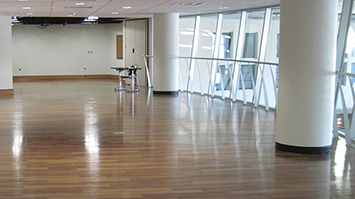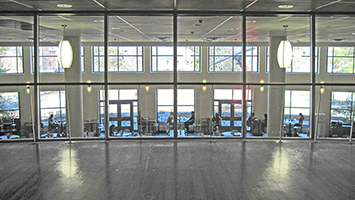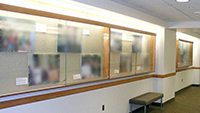
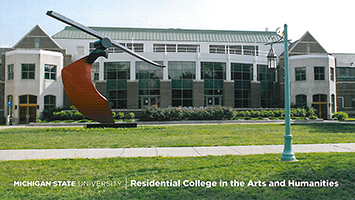
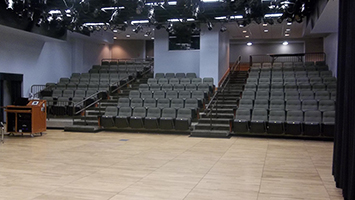
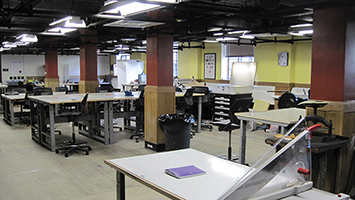
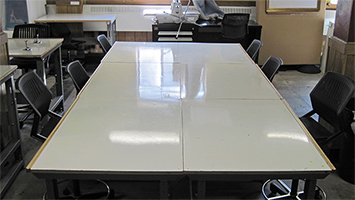
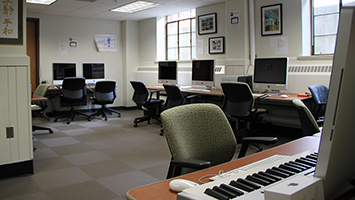
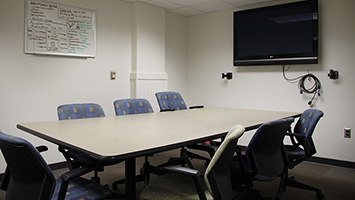
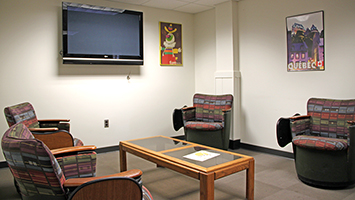
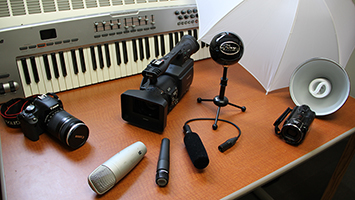
On the evening before the dedication ceremony, Van Alstine led a series of events aimed at helping participants understand the process of proposing, developing, and installing large public sculptures like Funambulist. The series began with a talk in the RCAH Theater (figure 5.2). Van Alstine walked attendees through a set of slides that depicted his sculptures and his process of proposing, designing, making, and installing them. Large works, like Funambulist, cost a lot of money, require a considerable amount of time and machinery to install, and are highly visible. He stressed that all stakeholders need to take steps to ensure the end result is a satisfying one. Van Alstine discussed his strategies for helping stakeholders envision what a proposed sculpture will look like when it is completed and installed: He takes photographs of the target site and then digitally inserts a model of the proposed sculpture into the photograph. If done with care, the rendering can help stakeholders anticipate the final result and can foster good decision-making. After Van Alstine's talk, a number of those present—including students, faculty, John Van Alstine, other artists, the dean of the RCAH, the RCAH instructional technology coordinator, and myself—walked down the hall to the RCAH Art Studio (figures 5.3 and 5.4) to participate in a workshop in which we went through a process that echoed the one Van Alstine had just described. Sitting in a circle around a large worktable, we made our own sculptures out of clay and metal scraps provided to us by Doug DeLind, a ceramicist who teaches part time in the college.
I was attending this event because one of the hats I wear in the college is director of the RCAH Language and Media Center (LMC, figures 5.5–5.8), a technology-rich facility with the mission of supporting world-language proficiency and media production. After participants created our sculptures, we photographed them using a digital camera against a green-screen background, two items borrowed from the LMC. Participants then walked across the hall to the LMC, where John Van Alstine and I guided them through the process of opening the digital images of their sculptures, bumping out the green-screen background, and then inserting the sculptures into photographs of public spaces across campus—photos taken earlier by student consultants who staff the LMC. Participants added elements to their photos to make them more realistic. Some gave their sculptures concrete foundations; others added grass, flowers, and passersby. Once the images were complete, we printed them out on one of the LMC's color printers. The next day, the prints were displayed at the Funambulist dedication ceremony in the LookOut! Gallery (figures 5.9 and 5.10). Later they were moved to a set of glass display cases down the hall, where they were exhibited for several weeks (figure 5.11).
I've thought about this series of events many times over the past few years because it crystallizes for me something about the way the RCAH is designed—spatially, curricularly, communally. There was a fluid quality to the activities Van Alstine facilitated: people came together, made stuff together, talked and joked about what they made, and then shared their work with the larger RCAH community. We made use of many different tools and resources: clay, scrap metal parts, large worktables, a digital camera, a green screen, computer workstations, swivel chairs, Adobe Photoshop, SD cards, multiple digital images, Google Image search, flash drives, a color printer. The activities of that night crossed various life domains. They were academic in the sense that they were supportive of an interdisciplinary arts-and-humanities curriculum. They were community-building activities in the sense that we all worked together on a common set of projects, and this shared experience reinforced a feeling of connectedness. They were recreational in the sense that we all elected to participate "for fun." Finally, these activities were enabled by various and proximate spaces: spaces for presenting, for making things with physical materials, for making things with digital materials, and for displaying the things we made.
The RCAH is the convergence of various elements: people, ideas, structures, paintings, sculptures, musical instruments, books, technologies, display cases, furniture. At any given time, some combination of these things is present in the various and proximate spaces of the College, located in a single building. Each day, there are new connections: one student bumps into another and initiates a conversation. A student discovers a new tool—like a digital paper cutter—and creates something in a new medium. A book falls into the right hands. A YouTube video watched by one person remains on the screen for another person to discover. I picture each of these connections as the kind of flare that happens when a handful of dry tinder is thrown into a campfire. Heat and light are given off.
In the series of activities that unfolded during John Van Alstine's visit, many heterogeneous elements connected, forming something larger, lively, engaging. A solar flare. These connections, flares, and the conditions that lead to them, are what I wish to explore here.
In this chapter I focus on the way various kinds of learning spaces can enable the formation of complex networks of various elements. I am particularly concerned with one "informal learning space," the RCAH Language and Media Center (LMC), and the way that space participates in and helps to nurture larger networks that are supportive of learning. I argue that it is productive to talk about the LMC as functioning within a larger "learning ecology"—a distributed, partially self-organizing system of learning processes.
I focus here on a series of multimodal compositions produced by one student. Based on this case, I formulate three hypotheses: (1) The production of multimodal compositions can be seen as a process of emergence enabled by complex networks operating within a broader learning ecology. (2) The ecology exceeds the boundaries of classes and classrooms. (3) While learning ecologies are unpredictable and contingent, design—the shaping of materials by humans for human goals—has a role to play.
